Northern Ireland and Belfast
As the capital city of Northern Ireland, Belfast is the final piece in the Great British jigsaw.
The city’s name means ‘mouth of the sand-bank ford’. It is the largest city of Northern Ireland – and the 12th-largest city in the United Kingdom and has a population of 343,542 as of 2019 – and stands on the banks of the River Lagan on the east coast.
By the early 19th century, Belfast was a major port. During this time it played an important role in the Industrial Revolution in Ireland, becoming briefly the biggest linen-producer in the world, earning it the nickname “Linenopolis”.
By the time it was granted city status in 1888, it was a major centre of Irish linen production, tobacco-processing and rope-making. Shipbuilding was also a key industry; the Harland and Wolff shipyard, which built the RMS Titanic, was the world’s largest shipyard.
Yet it’s been far from smooth sailing for Belfast; especially in recent time. The city – as has been well documented – suffered greatly during the violence that accompanied the partition of Ireland, as well as during the more recent conflict known as the Troubles.
But it is also a city that is on the up. With its rich heritage from its industrial past, as well as become a hub of film and TV making (in no small part due to it being a key location for the hit HBO show; Game of Thrones), tourism has been growing in Belfast and indeed in Northern Ireland in general.

During my life to date, I have been to Northern Ireland just twice.
The first was a dedicated trip to Belfast to take in the city and the surrounding area, while the second saw Holly and I visit the northern parts of Northern Ireland – near Derry – as we went to a friend’s wedding just across the border in Donegal, Ireland during August 2020.
So while this blog features Belfast it will be extending it to areas outside of the city’s boundaries that many will want to visit during a trip to the Northern Irish capital.

I had a very set idea of some of the things I wanted to see, and do, in Northern Ireland. First and foremost was a trip to Giant’s Causeway to stand among its many columns and witness this extraordinary piece of nature.
Next was to see the Titanic exhibition in Belfast. As a massive Titanic nerd growing up, to go to the place where the legendary ship was built and launched from was a no-brainer.
My final thing was to visit the various sites where Game of Thrones was filmed as I loved the show when it was on (as readers of World Complete will know from other blogs – see Dubrovnik).
But that is far from all that can experience in this wonderful corner of the United Kingdom.
So what does a visitor to Northern Ireland and Belfast need to know before setting off?

If you are travelling from somewhere else in the UK, then fortunately you don’t have to worry about issues such as currency (Northern Ireland uses the Great British Pound) and language (English is the main language used in Northern Ireland), while driving remains on the left side of the road, there is no time-zone difference and plug points (plug type G) are as you would find in the rest of the UK.
These similarities make a trip to Northern Ireland that bit easier than a similar trip elsewhere in the world.
Yet despite this, there are a couple of things that visitors should know before setting off.
The first thing is that Northern Ireland’s climate is usually very moderate but – on occasions – can get very hot.
During August, the daily mean temperature for Belfast – for example – sits around the 15°C mark but on hot days this can escalate to nearer 28°C! However, even if the country is experiencing a hot period, it’s best to plan for wet weather in Northern Ireland.
On average, during August, there are still almost 13 days of rain a month which means that a nice day can turn into a wet one very quickly. It makes planning a trip that bit harder as the need for sun lotion and umbrellas can both be called into action at a moment’s notice.
Another thing to note is that – if you are a British citizen – then technically you do not need a passport to enter Northern Ireland as it is part of the UK, but you do need ID to board either a plane or a ferry.
So, while a passport is not needed, I’ve taken mine with for for the trips I’ve been on in order to avoid any complications. If nothing else they can act as my ID anyway.
I’m sure there are other things to note, and I’d always advise doing your research in full about a place before travelling. However, with these simple things in mind then I’m sure a trip to Northern Ireland will be as enjoyable and fun-filled for you as it has been for me.
Getting there
Getting to Northern Ireland is a relatively easy affair and can be done by both air and ferry. However, for the purposes of this blog I’m only going to focus on the air travel as that is how I have arrived both times I’ve visited.
My first suggestion for air travel is for those who wish to use Belfast as their base.
Belfast International Airport is around 13 miles northwest of the city centre itself and is the main focus for flights from mainland United Kingdom to Northern Ireland.
Each year, around 6 million passengers pass through the airport’s gates, although this figure fell through the floor in 2020 (for Covid-19 reasons) with only 1.7 million passengers using the airport!
There are numerous flights – all with EasyJet – that take travellers from London Luton, London Stanstead and London Gatwick, as well as from Birmingham, Bristol, Manchester and Newcastle-upon-Tyne in England and Edinburgh and Glasgow in Scotland.
When I flew Belfast – one June – I took the route from London Stanstead (for just £87.96 per person for a return flight) which took around an hour and fifteen minutes to complete. Once settled into my seat, a good podcast episode was all I needed to see the time fly by.

My second suggestion is for those who wish to be based outside of the capital – or indeed across the border in the Republic of Ireland. For that, I’d suggest flying to City of Derry International Airport.
This a regional airport located around seven miles northeast of Derry and is situated on the south bank of Lough Foyle.
Very few flights operate from this hub with only seasonal flights going to Spanish locations while Ryanair also operate flights to Manchester. The rest of their flights arrive in England (Liverpool and London Stansted) and Scotland (Edinburgh and Glasgow) via Scottish-flight provider, Loganair.
This small company operate an extremely friendly and efficient service. During the short flight – that only takes around an hour and 25 minutes – we even got a small snack of Scottish shortbread and drink of water to enjoy which other budget airlines fail to provide. A small gesture, but a nice touch that they certainly don’t need to offer.
For an August-trip – that saw us fly return to Derry from London Stanstead – it cost us £148.84 per person; a price that also included one suitcase below the plane (something we needed as we headed out to Ireland for a wedding). Without this extra suitcase, the cost would have been cheaper.
Again a good podcast or couple of chapters of a book later, the flight was over and we were free to explore Northern Ireland.



Where to stay
My first trip to Northern Ireland saw me visit – and stay in – Belfast.
In the city itself there are a number of great hotels and apartments to stay in but on this occasion there were three of us travelling and we wanted to stay in the same place.
For our needs we sourced this great AirBnB just on the outskirts of the city centre for just £249 total for a three night stay!
Located in the Quay Gate Apartment building on the corner of Station Street and Middlepath Street, this comfortable apartment gave us a great spot to settle into for our three nights in Belfast.
The apartment has a large living space and kitchen for all your needs and also has two bedrooms and two bathrooms meaning it is suitable for friends to share or for more than one small family to stay in.
Best of all, it’s just a short walk – across the River Lagan – to the city centre’s Cathedral Quarter (perhaps a 10 – 15 minute walk) where you’ll find all manner of bars, shops and restaurants.
A real gem and a great place to pitch-up for a short city break in Belfast.
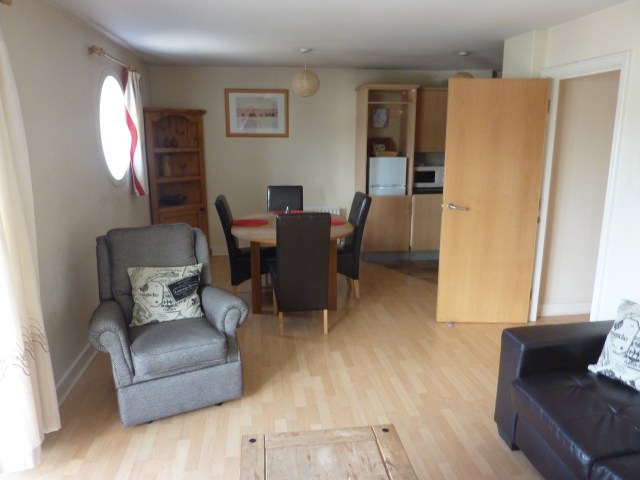

My other suggestion for those looking to stay outside of Belfast is a bit of a cheat. By that I mean it’s not actually in Northern Ireland itself, but just across the border in the Irish town of Donegal.
For the trip Holly and I took one August – for our friend’s wedding – we decided to stay in the wonderfully welcoming Donegal Town Independent Hostel just off the N56 near Donegal town centre.
This find turned out to be a real bargain. For just £186 total, Holly and I stayed in our private room at the hostel for four nights – a mere fraction of the price we could have paid should we have chosen any number of other hotels or AirBnBs in the local area.
Included with that price was free parking in front of the hostel within its grounds and use of the communal kitchen (which included teas and coffees free of charge but we had to supply our own food to consume) as well as our own private bathroom.
So why pick this location to explore Northern Ireland? Well, firstly, Donegal is extremely near the Irish border meaning – if you have a car – you can get in and out of Ireland / Northern Ireland extremely easily.
While the hostel is about an hour and a half drive from City of Derry Airport where we arrived, the beautiful surroundings of the hostel and the kind hosts more than made up for this.
It is well situated for those who want to either explore the norther reaches of Ireland – along the Wild Atlantic Way – or the northern parts of Northern Ireland down to Giant’s Causeway and inland to Omagh.
Upon arrival we were greeted by our hosts and shown to our room, while also being given a few helpful tips about the local area and places to get a good bite to eat and something to drink.
We quickly became a firm fixture within the hostel as our stay – I’m led to believe – was slightly longer than most people do but we felt so at home that it was a burden to leave when the time came.





Getting around
First thing to say is that Northern Ireland – like much of the rest of the UK – is fairly easy to navigate by public or private transport as well as on foot where needed.
For a starting point, if you are arriving into Belfast International Airport then you can either hire a car (more about car hire – albeit from Derry – in a bit) or use the very efficient Ulsterbus Airport Express 300a.
Located just outside the main you’ll want there are numerous bus services that take you to various parts of Northern Ireland – as well as into Ireland – but if you are headed to Belfast City Centre then you’ll want to hop on the 300a service.
This service costs around £8 per person for a single journey or £11.50 per person for a return. The 300a service operates seven days a week and, at peak times on Monday to Friday, the service run every 15 minutes!
The journey itself takes around 40 minutes and goes via Broadacres, Castle Gates and then onto the Europa Bus Centre located on Glengall Street – to the west of the River Lagan.
This simple, cheap services is great for those that don’t want to hire a vehicle and are planning to remain in the city centre. However, with a wealth of activates outside of Belfast to see and do; hiring a car may be beneficial.
This was our thoughts when Holly and I flew to Derry.
Firstly, we were obviously not staying in Derry so we needed the freedom to get around quickly and easily and to cross the Irish border.
Ahead of arriving in Northern Ireland we booked the hire of a small economy car – which turned out to be a Volkswagen Golf – via Holiday Autos.
When you go to collect your car, remember to have your full UK drivers licence photocard with you as well as a credit card. Without these, you’ll not get to drive away.
We booked the car for four days at a cost of £106.50 in total – or £26.63 per day. This fee included taxes and unlimited millage with fuel levels having to be returned to full on the return of the car.
If you are planning to drive across the Irish border as we were, however, do tell the car hire company when you go to collect the car. By doing this, they can extend the insurance and protection you have so it covers taking the car ‘abroad’.
The counter staff will fill in a VE103 form for you, which allows you to take a hire car into a new country temporarily. The car will then be covered for both the Republic of Ireland and the UK making you free to explore both.
Also, the rental company will probably charge a ‘cross-border fee’ when you pick up the car. This fee will extend your rental’s basic damage, theft and third-party protection across the border. The fee varies by rental company, but it’s usually around £25/€30 per rental.
And, to make matters easy for those used to driving in mainland UK, Northern Ireland and Ireland both drive on the left side of the road (sorry European visitors).
With the hire of a car, it gives you freedom to explore Northern Ireland at your own speed and allows you to enjoy sites – such as Giant’s Causeway – without having to worry about getting on a tour bus at a certain time.

Top sites
Using Belfast as a base can open up a number of interesting places to visit within a very short distance of one another. Primary among those is that of Titanic Belfast.
As a child, the story of Titanic always fascinated me. So I was never going to pass up the opportunity to visit this wonderful museum while in Belfast.
This impressive museum and exhibition is located on the Hamilton Docks. This spot is vitally historic as it marks the point where the legendary vessel first entered the water via the slipway (which are still accessible to this day).
The Titanic Experience describes itself as the world’s most authentic retelling of the iconic story. From creation to that fateful night on 15 April 1912, the museum crams huge amounts of detail inside its iceberg shaped walls. And, perhaps appropriately, like an iceberg, there is a whole lot more to the Titanic’s story under the surface than that which has been well documented on television and film.
For £21.50 per adult, we were were able to dive into the history of Titanic and learn more about those on board the great ship as well the background of her tender vessel; the SS Nomadic (which is sat outside the museum in dry-dock).
The experience itself is a self-guided one that takes you through nine interactive galleries, exploring the full Titanic story. It takes around an hour and 45 minutes to do in full. As an added bonus, you also get admission to SS Nomadic outside the museum; the last remaining White Star Line ship in the world which has been painstakingly restored to her original glory!
I’d advise booking tickets online before you visit as this not only allows you to pre-select your timed entry spot, but also helps you to avoid the queues on the day.
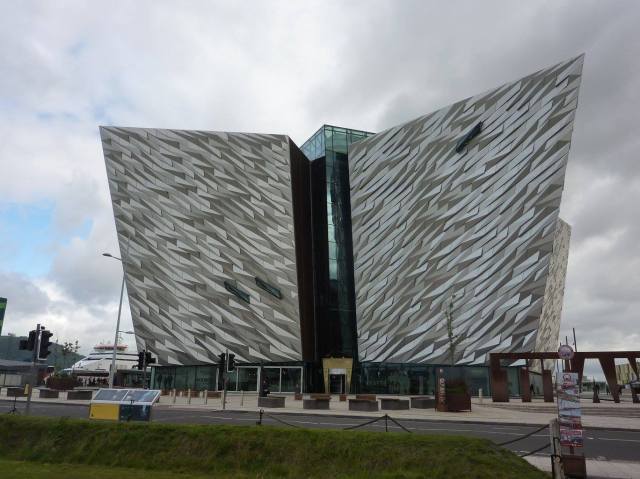





Keeping things light during a visit to Belfast is always important, so what better way of doing that, than a visit to the infamous Crumlin Road Gaol!
The prison was built in the early-to-mid 1800s and it was originally designed to house up to 550 inmates at a time. In its formative years, the prison was said to be the first in Northern Ireland to be built according to “The Separate System”, which was intended to separate prisoners from each other with no communication between them.
As the years passed, however, more prisoners were sent to Crumlin Road and – especially in the early 1970s – as many as three prisoners were placed in each cell at a time.
The prison is located on – unsurprisingly – Crumlin Road, which is situated to the north-west of central Belfast. You can get public transport here, but it is just as easy to walk the mile-long journey.
An interesting fact is, that just opposite the prison – on the other side of Crumlin Road – is the old Court House. Now in a state of disrepair and awaiting redevelopment into something new, this court house has an underground tunnel that runs from it to the prison. It was in this tunnel that convicted prisons would be led to the prison after their trial to conduct their sentences.
While many prisoners would be released upon completion of their sentences, the prison was also one used for execution by hanging.
Yet, when it was originally designed, the prison did not contain a gallows and the executions were carried out in public view until 1901.
At this point an execution chamber was constructed within the prison walls and used until the last of the hangings took place in 1961. In total, 17 prisoners were executed in the prison; the last being Robert McGladdery who was hanged in 1961 for the murder of Pearl Gamble.
In a slightly twisted set of events, the condemned would be kept in a cell, large enough for two guards to live in as well, that would open straight up into the gallows where they would be taken on the day of their execution, and hanged. The bodies of the executed were then buried inside the prison in unconsecrated ground, against the back wall beside the prison hospital.
While it may not be one for the faint-hearted, the stories on offer here are extremely interesting to read and hear. During a trip around the prison – led by one of their informative guides – you’ll hear about these tales up until it’s closure in March 1996.
As with the Titanic Belfast exhibition, I’d advise booking tickets online in advance of a visit. If you buy your tickets on the day it costs £12 per adult, while booking in advance will save you a little bit; costing just £10.80 per adult.
In total you’ll spend about an hour and a half on the tour – which is a considerable amount less time in the prison than many spent while it was in operation.
For those looking to grab something to eat afterwards, you can stop in at the prison’s own restaurant ‘Cuffs’ for a quick spot of lunch or dinner.

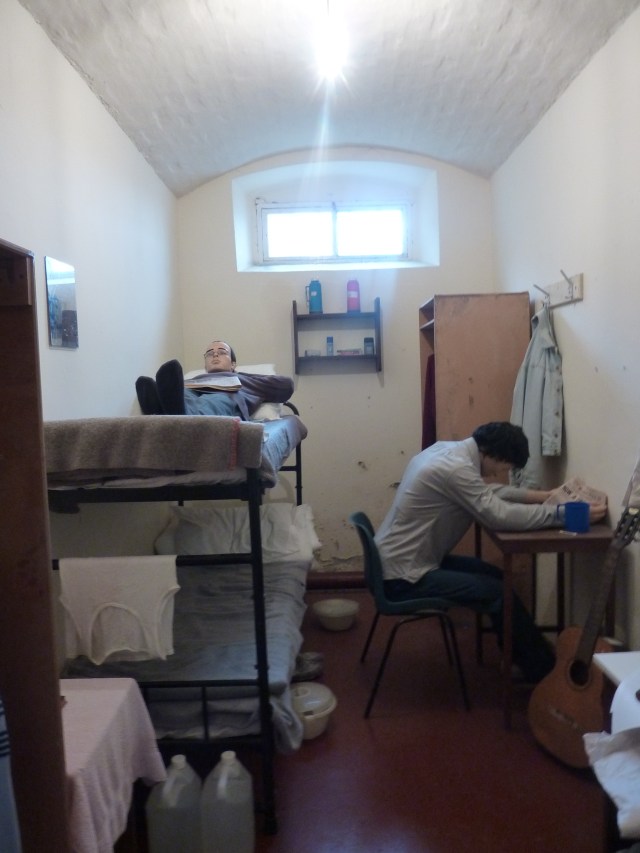



Perhaps Northern Ireland’s best known landmark is that of Giant’s Causeway.
This is the first of my suggestions that is located outside of Belfast – but one that can be easily reached by car from the capital or from the northern tips of Northern Ireland. It also features on many tours operated in the region.
Located in County Antrim on the north coast of Northern Ireland, Giant’s Causeway is around three miles north-east of the town of Bushmills and really shouldn’t be missed.
This mind-bending natural wonder is even more puzzling to see in person. The area is made up of around 40,000 interlocking basalt columns – all of which were formed as the result of an ancient volcanic fissure eruption.
Flanked by the wild Atlantic Ocean on one side and surrounded by the beautiful landscape of dramatic cliffs on the other, Giant’s Causeway is Northern Ireland’s only UNESCO World Heritage Site.
For just £13 per adult, you can get yourself a Visitors Experience ticket although it is possible to walk the stones for free if you enter by walking along the cliff top and then down the stairs that take you to the columns.
I’ve been to Giant’s Causeway twice in my life at the time of writing. The first was as part of a wider Game of Thrones tour so meant that I only got to spend around an hour here which isn’t long enough.
The second time I came, Holly and I drove to the site and parked in the car park – at a cost of £5.
The first thing you’ll notice is the large visitors centre which you’ll make your way through with your tickets (if you’ve opted for this option as we did). Inside here there is also a small café, gift shop, toilets and some interesting exhibits about the Causeway itself.
After spending a short time inside, we made our way through the back – showing our tickets to the member of staff on the door, and down the long, winding road to where the stones are; some one mile down the coastline.
While it is a steady descending walk down to Giant’s Causeway, remember you either have to come back up the same way you go down or make your way up the stairs on the cliffside. Either way, going down is a lot easier than coming back!
The views as you walk along the road do really showcase just how beautiful the Northern Irish coastline is. Waves crash into the rocks and cliffs and on a clear day you get great views out towards the Atlantic Ocean.
The sight of the stones will start to become more and more apparent as you make your way closer to where the main cluster is. Once down on the rocks, you can climb up the columns, sit on and observe your surroundings.
There are a few things to keep an eye out for. The first is the Giant’s Boot which is a curved shaped stone set along the coastline away from some of the main columns and another is the Chimney Stacks, set high on the cliff side.
We found that, to get the best value for time here, it’s best to spend a good couple of hours exploring the area. This will give you plenty of time on the columns and allow you to climb up the path onto the cliffs where you can get great views down onto Giant’s Causeway from above. This viewpoint is really not one you’ll want to miss.
Thing to remember. As previously mentioned, Northern Ireland – like much of the UK – has very changeable weather. So if you are going at certain times of year, make sure to take some waterproof clothing for sudden downpours as well as warm clothing to protect against the winds.
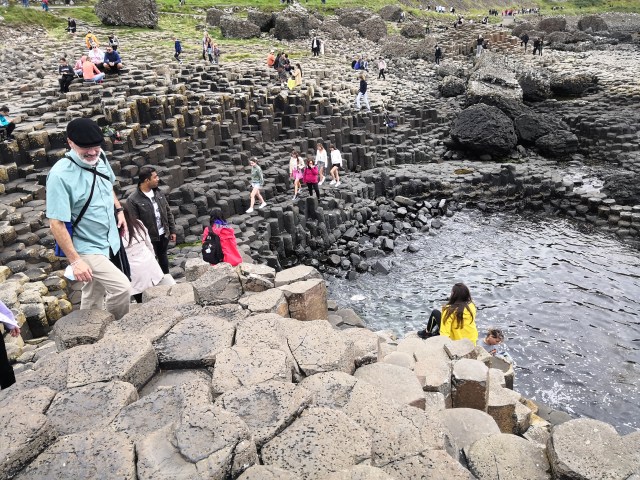



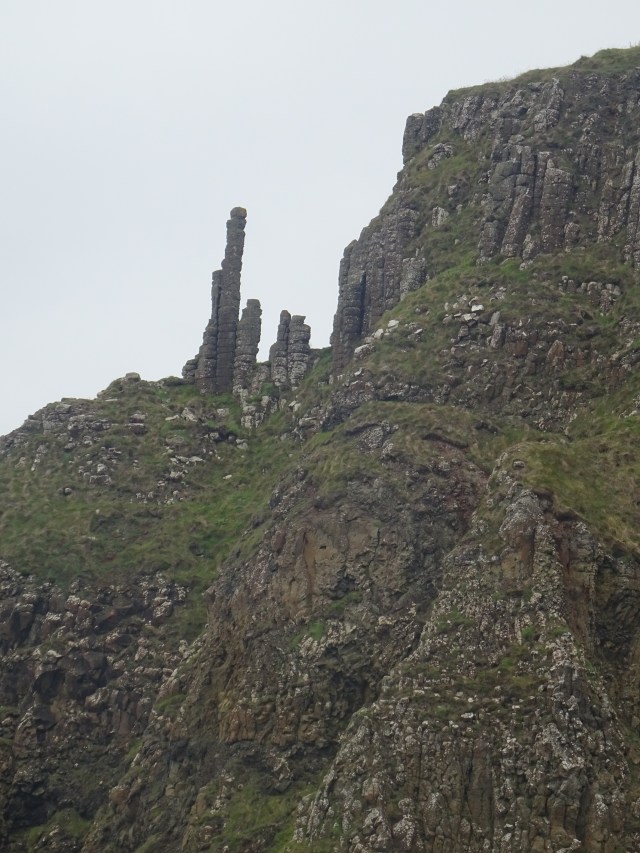

A stop that will also feature on one of the Game of Thrones tours (as it was a site used when filming scenes from the Iron Islands) is that of the National Trust’s Carrick-a-Rede Rope Bridge.
Yet, even if you are not a fan of the show – or not planning on going on one of the tours – this site is one that is worth visiting; if you can stomach a bit of a height.
The rope bridge can be found near the Northern Irish town of Ballintoy in County Antrim and it links the mainland to the tiny island of Carrickared.
Spanning some 20m, the bridge hangs around 30m above the rocks below; which means for those who have a real fear of heights – or unstable surfaces – this may not be one you want to do.
The only way on and off the small island is by the rope bridge which was first erected by fishermen more than 250 years ago.
The bridge itself is about a 20 minute walk – or around a 1km distance – from the Rope Bridge car park. When you get there, you will notice a wooden hut next to the car park. Parking at the Carrick-a-Rede Rope Bridge is free but you do have to pay £6.50 per person if you want to cross the bridge itself.
Again, I’ve been to this site twice in my life. The first time was as part of a Game of Thrones tour and was able to cross the bridge after paying the fee. The second time – which occurred during the Covid-19 pandemic – saw the bridge shut for renovations so while Holly and I were able to walk up to where the bridge was, we were unable to cross it and go onto the small island.
That being said, you do still get some wonderful views of the surrounding area during the walk down to the bridge as well as of the bridge itself when you get there.



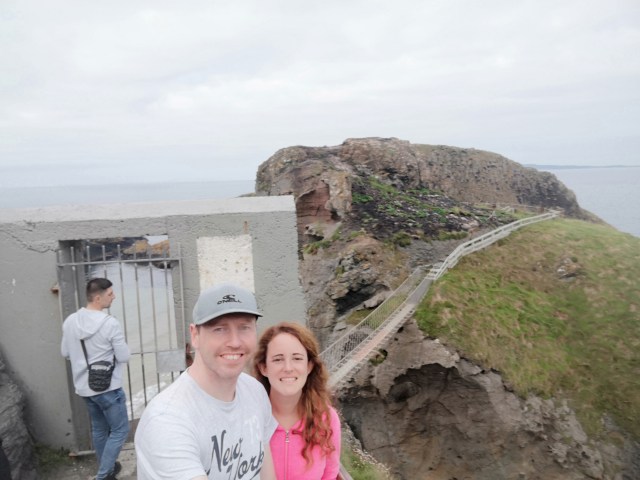



Another stop that Game of Thrones fans may recognise from the second season of the show is that of The Dark Hedges.
This beautiful avenue of beech trees – actually on a road call Bregagh Road – was originally planted by the Stuart family in the eighteenth century.
This rather ominous looking – yet distinctive and beautiful road – was intended as a compelling landscape feature to impress visitors as they approached the entrance to the Stuart’s Georgian mansion; Gracehill House.
Some two centuries later, the trees remain a magnificent sight and have become one of the most photographed natural phenomena in Northern Ireland.
This free-to-visit area again can be seen on one of the Game of Thrones tours (more on that in a minute) or – if you have a car – is just a 15 minute drive inland from the Carrick-a-Rede Rope Bridge.
If you do drive, then there is a large, free, visitor car park provided by The Hedges Hotel located just off Ballinlea Road. This is an easy two minute walk from the north end of the Dark Hedges and there is a marked path to follow near the parking area to get to the trees.
Be aware that this road gets very busy at prime times in the day, so be prepared to be patient to grab the photos you want to take. Also be prepared to accept that it is unlikely you’ll get too many – if any – without anyone else in the shot.
Last thing to note is that you’ll need to remember that this is a normal road. By that I mean that cars can – and do – come down it so make sure you don’t leave anything (or anyone) in the middle of the road while you go off to grab a picture.
As with the Rope Bridge, I’ve been here twice now. The first again was with the Game of Thrones Tour and the second time was in the car with Holly.
Even on my return visit the trees are just as eerie as they were on the first one and it’s really interesting to see how they’ve grown into their current shapes as the years have passed.


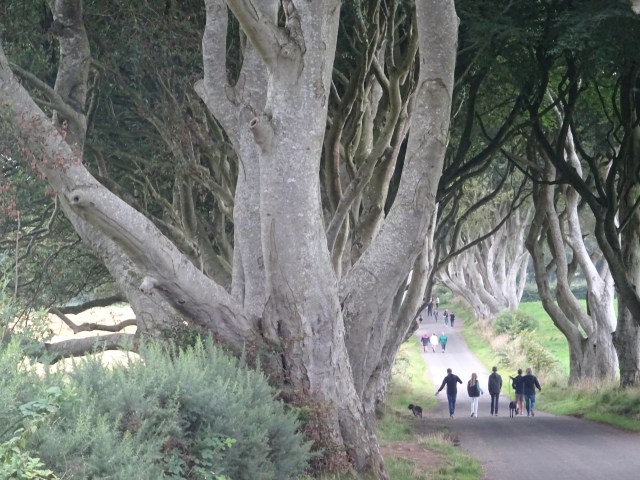

My final suggestion is one that has had mentions in numerous sections of the above blog. So if you are like me, you’ll be dying to do at least one of the Game of Thrones Tours during a trip to Northern Ireland.
At the time I went there were two tours available. The first was called the Belfast Iron Islands Adventure and takes you to many locations in Northern Ireland where scenes set on the Iron Islands were filmed.
This tour visits the Glens of Antrim and the dramatic north coast of Northern Ireland. During the tour you’ll visit the Dark Hedges (as mentioned earlier) the Iron Islands beach where Theon dedicated his faith to the Drowned God, the breath-taking Giant’s Causeway (again as mentioned earlier) and the Stormlands cave where Melisandre gave birth to a dark spirit.
One great aspect of the tour is that all the guides were all extras in the show and genuinely love it. As a bonus they also carry Iron Born costumes, metal props and Greyjoy banners in the trunk of the coach which they offer to guests at the location of Lordsport on Pyke Island for a few photo opportunities.
The second tour I did was the Belfast Winterfell Locations Trek and – as you’d expect from the title – this focused more on scenes shot in and around Winterfell.
This tour visits locations associated with House Stark in the early seasons. The first visit of the day is Inch Abbey, the crumbling 12th century stone church where Robb Stark became ‘King in the North’.
Close by is Old Castle Ward; the original location of Winterfell Castle in season one. After lunch, you get taken to the enchanting depths of Tollymore Forest which featured as the Wolfswood where the Starks find the Dire Wolf pups.
A new aspect to the tour – which wasn’t on offer when I did it – is that they now drop guests off at the Game of Thrones Studio Tour so visitors can complement their experiences of real locations with a visit to the real sets!
Each tour takes between nine and ten hours and will see you picked-up and dropped off in central Belfast. For our tour we were met and dropped off outside the Top Shop on Chichester Street – but this location may have changed. In fact, I believe that the current pick-up point (at the time of writing anyway) is the front door of Jurys Inn hotel on Great Victoria Street.
At the time of writing, prices are £45 per adult for each of the two main tours. This does cover all costs for the day however – minus any food and drinks you want to buy as well as any souvenirs – which represents good value.
The days are tiring so be sure to get some good rest the day before you take them as well as on the coach – where the guides often speak to the group about the show or play an episode or two of the hit show on the coach’s TV system.







Where to avoid
Northern Ireland – like much of the UK – is a very safe place for a tourist to visit with the vast majority of trips being undisturbed and trouble free.
Yet as with Ireland as a whole, Northern Ireland has, of course, suffered with its well document ‘Troubles’ in the past and there are a few slight hangovers from these times – especially in parts of Belfast.
The majority of incidents are committed by local people against local people, unsurprisingly following religious, sectarian or political differences. Tourists are – mostly – outside this culture and therefore need to not be very concerned.
But as with any other city, it pays to be careful and always be aware of your surroundings. Do not flash valuables or money or walk around reading your guidebook or map.
There are areas in Belfast which have been scarred by trouble in the past. Though these areas are largely safe to visit, it is important to be aware of where you are. In nationalist areas of the city, it would be foolish to wear a Glasgow Rangers, England, or Northern Ireland football jersey.
In unionist areas, wearing Glasgow Celtic, Republic of Ireland and Gaelic Football (GAA) jerseys would almost certainly lead to trouble. Though this is unlikely to affect tourists, it is best to avoid wearing green or orange or the name of any area, especially Northern Ireland, Republic of Ireland or England.
The City Centre is generally a safe area but it’s probably best to avoid leaving the main streets at night – especially if you are on your own – and try not to venture into dimly lit streets.
The easiest thing to do to avoid any issues is to not make any overtly political statements about Northern Ireland, even if you think that your comments will align with the views of the people to whom you’re making them.
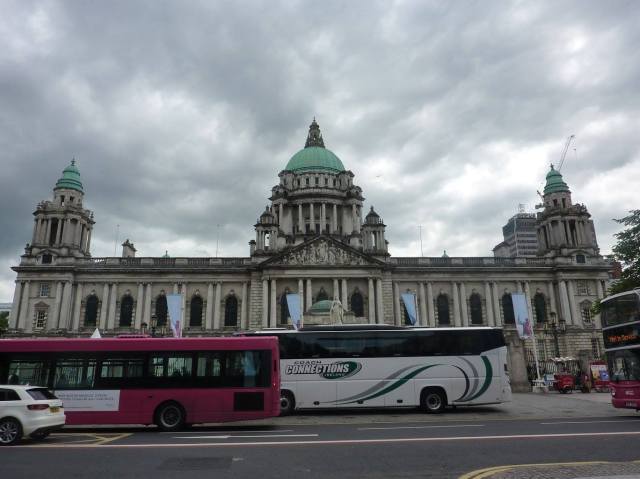
Great places to eat
Northern Ireland is littered with great places to eat and get a drink. I mean, you are litterally falling over yourself for bars and restaurants.
From fast food to fine dining, from quiet pubs to rowdy bars; it has it all!
For the purposes of this blog I’m going to focus on my favourite bar / restaurant that I enjoyed a couple of times in Belfast; the delightful Bootleggers!
This unassuming treat is based in the city centre on the corner of Ann Street and Church Lane. You can drop in for a few drinks or, stay a little longer, to grab some filling and tasty food while enjoying the lively surroundings.
The menu is plentiful. A good selection of tacos and burgers make up the majority of the food while you can also enjoy a selection of tasty sides including their famous chicken wings and nachos all for a reasonable price.
There are a few things here that are worth trying out. For example, the OG Burger – two patties, smoked bacon, cheddar, pickle, lettuce, tomato, red onion, ketchup and mustard – is a naughty treat while the Buffalo Billy tacos – southern fried chicken, cheddar, hot sauce, aioli and lettuce – make for a welcome lunch.
Save room as well for a dessert and make sure you order the Belly Buster – chocolate ice cream served with brownie chunks, whipped cream, hundreds & thousands, chocolate and strawberry sauce, chocolate flakes, honeycomb and a cherry on top.
And on top of this great food is a decent range of draught beers, wines and spirits to boot – although it’s almost criminal to visit Northern Ireland without sipping on at least one pint of Guinness!
Best of all, this bar will not set up back too much in the pocket either. A decent, filling, meal for two including desert and drinks (if you only have one or two) will cost around £60 – £70 and will give you a great location to chat and plan your next activates in this British gem.

Useful links
Donegal Town Independent Hostel
Ulsterbus Airport Express 300a
Remember you can follow World Complete on Twitter, Instagram, Pintrest, Tumblr and Facebook send your comments and pictures from your travels using #WorldComplete and #Travel.


This sounds like such a wonderful trip!
I also don’t think I’ve seen a hostel as pretty as Donegal Town hostel – wow! So picturesque!
LikeLiked by 1 person
Thanks so much for your kind comments. Glad you enjoyed the blog
LikeLiked by 1 person
It must have been amazing. Personally,within UK, I have only visited London but Ireland is a place I want to visit. I will definitely come back to this post because you have so much info. I loved the photos on the bridge, allthough a bit scary.
LikeLiked by 1 person
Thanks so much. If you get to Ireland I’m sure you’ll love it. And be brave and try the bridge. It will be worth it
LikeLike
I haven’t visited Northern Ireland yet. It must be gorgeous!
LikeLiked by 1 person
It really is. Great place to visit if / when you get the chance. 😀
LikeLike
Looking like you had fun at Winterfell. I would love to visit in future.
LikeLiked by 1 person
It was great fun. Hope you get the chance to go in the future. Thanks for stopping by my blog.
LikeLiked by 1 person
I’ve only visited Ireland once but didn’t really get to do much visiting of historical/cultural places so I would love to go back and visit the footsteps — really informative post!
LikeLiked by 1 person
Thanks so much for the kind comments. Ireland and Northern Ireland are both really beautiful places to explore. Highly recommend it. Glad you enjoyed the post 🙂
LikeLike
what a great trip!
LikeLiked by 1 person
Thank you. It was a lot of fun. If you enjoyed this trip, you may enjoy my blog on my road trip around England, Scotland and Wales https://world-complete.com/2020/07/31/the-great-british-road-trip-exploring-england-scotland-and-wales/
LikeLiked by 1 person
I’ll check it out, thanks
LikeLiked by 1 person